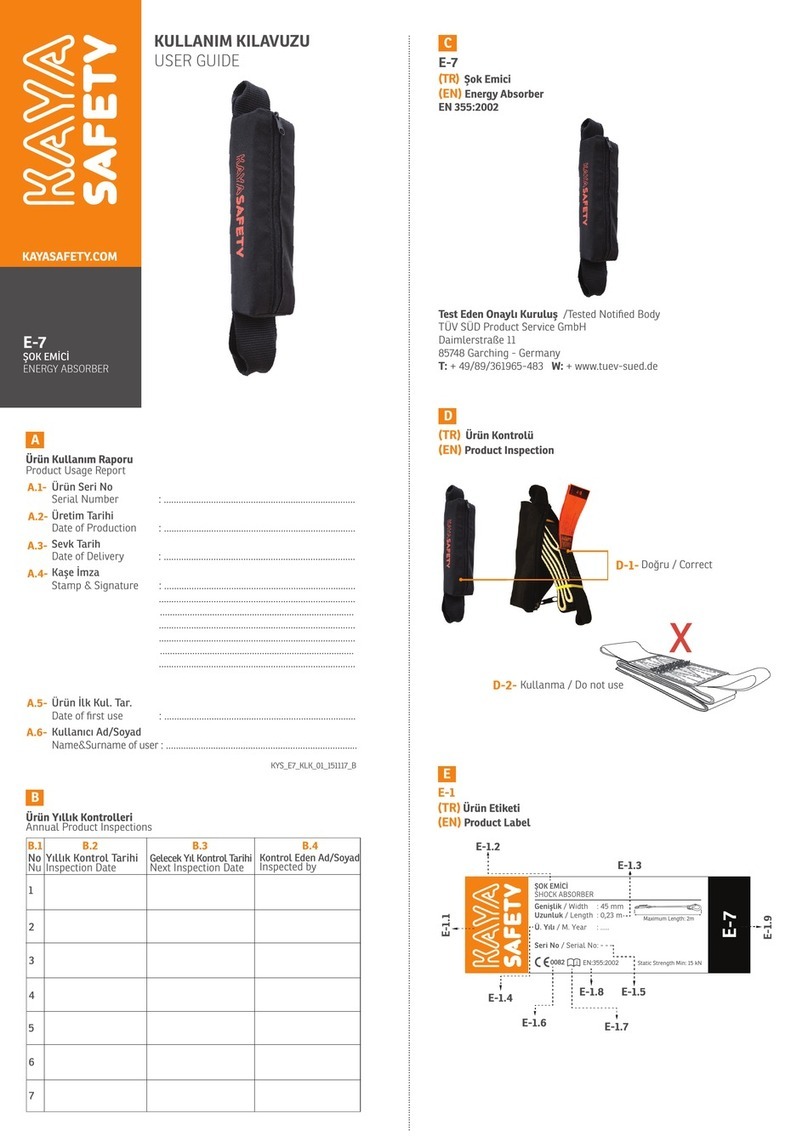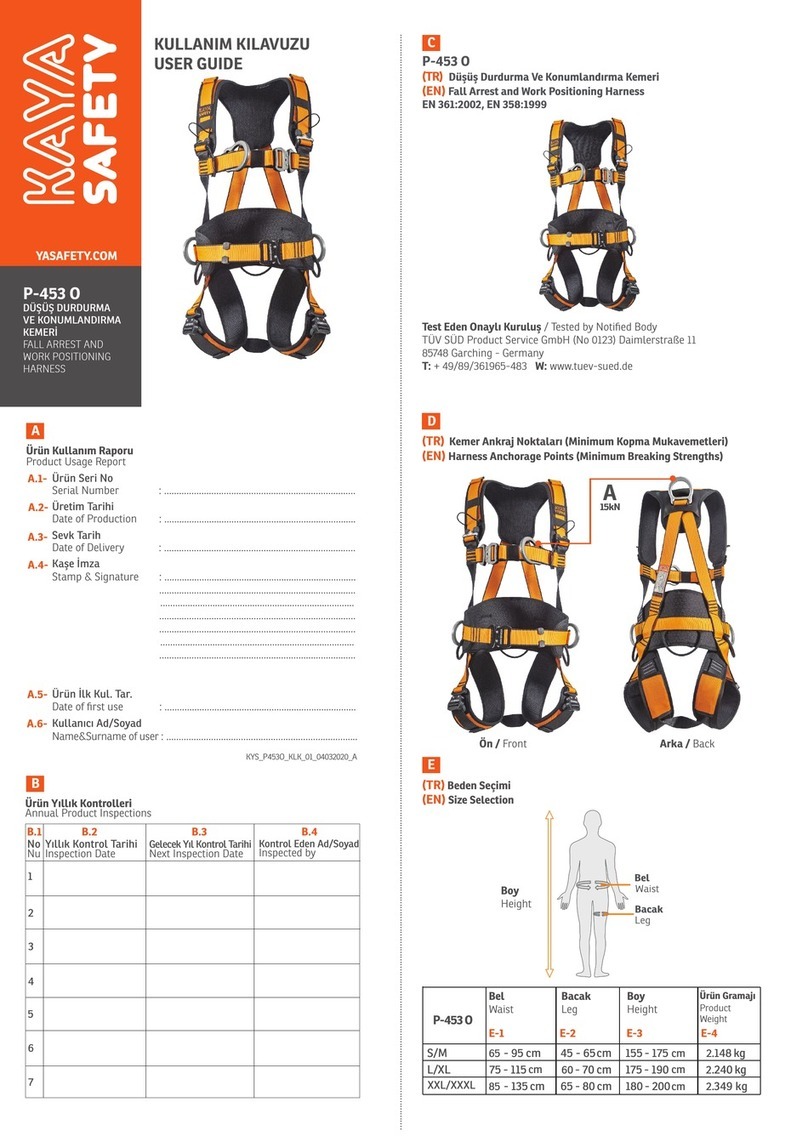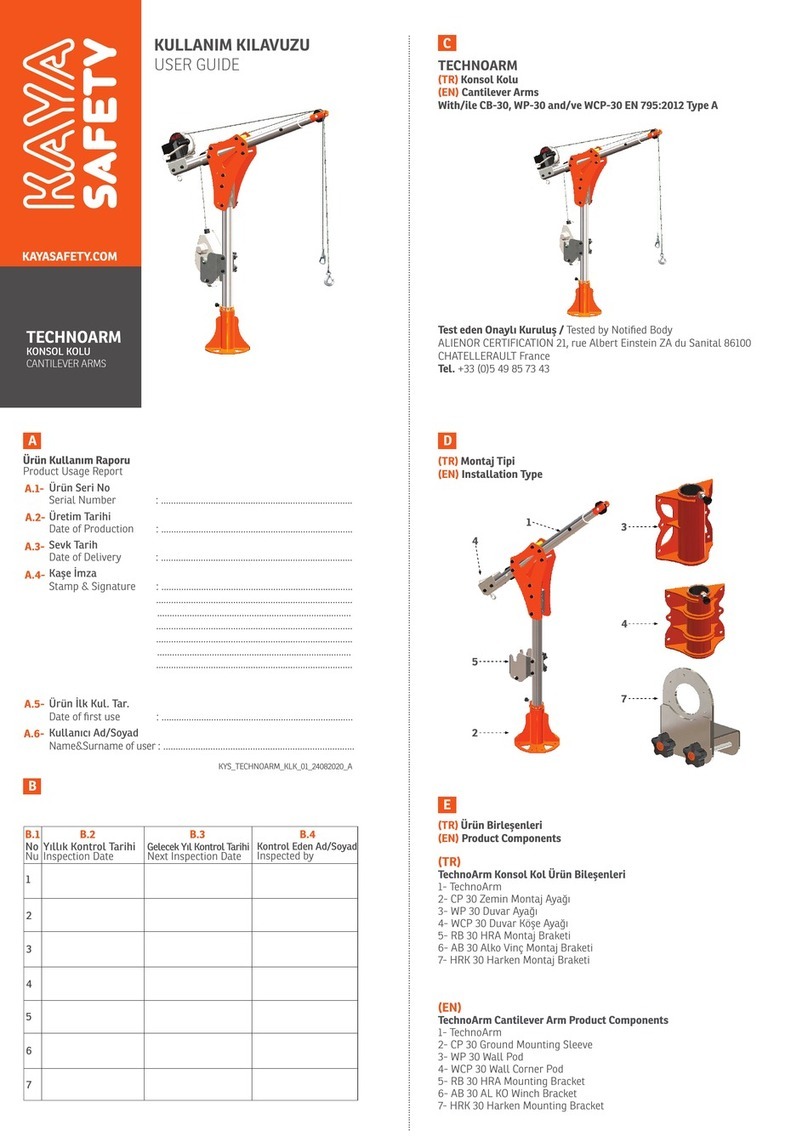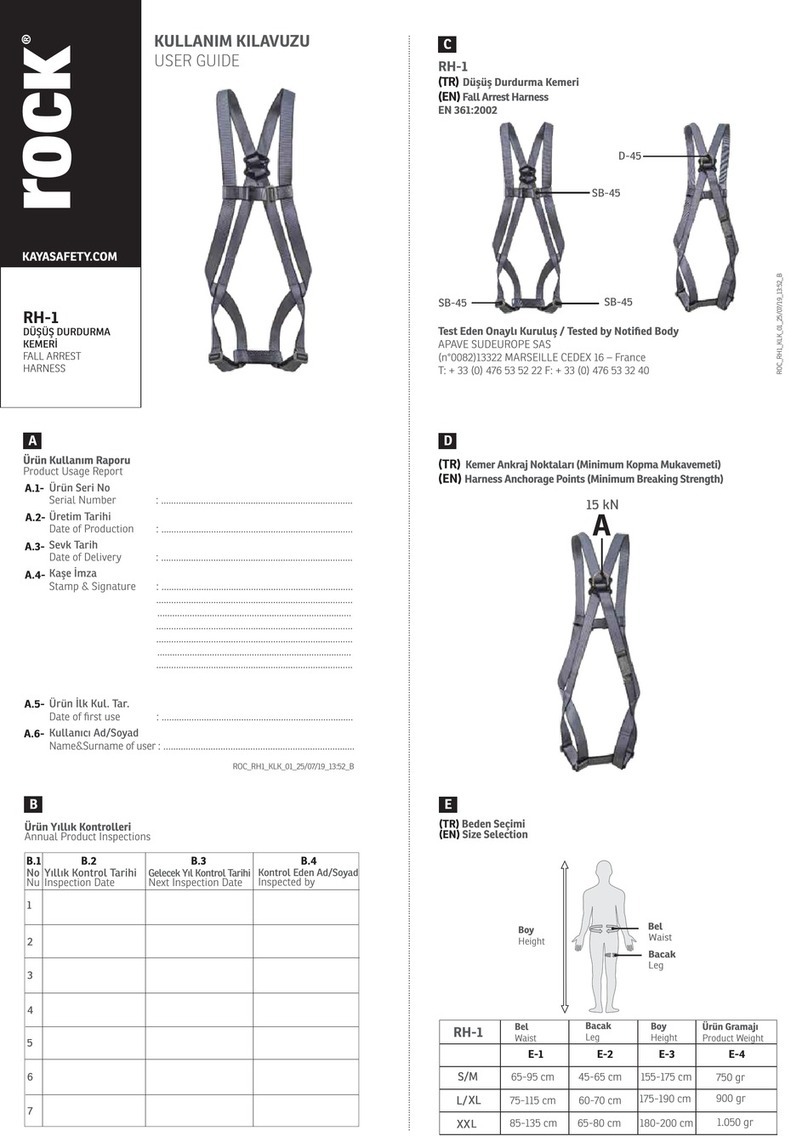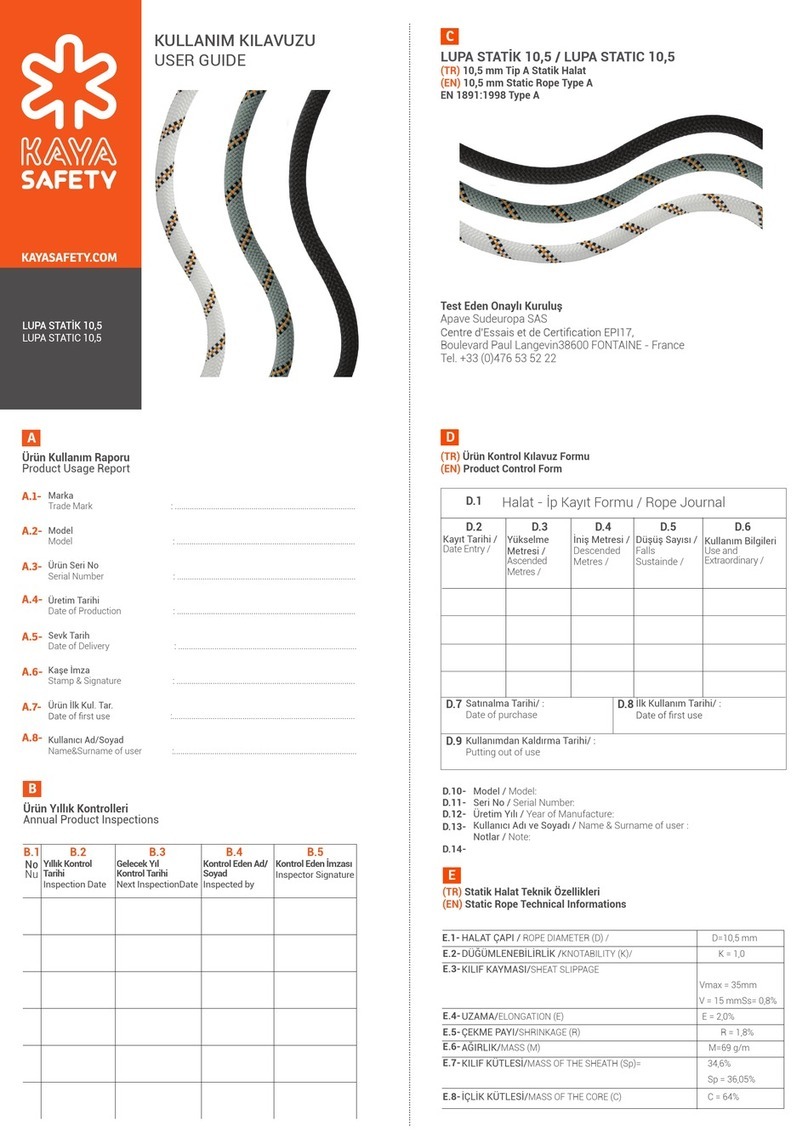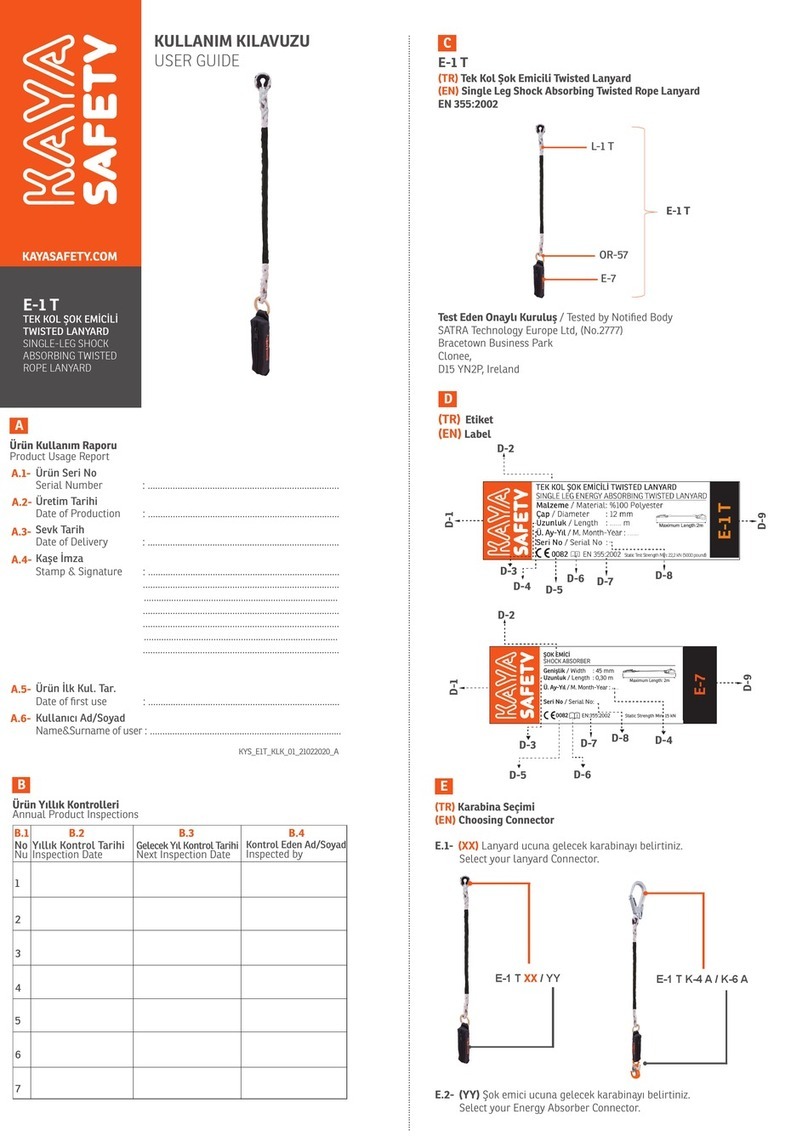
.........................................................................................................................................................................................................................................................................................................................................................................................................................................................
* Connect both ends to the anchor point using certified carabiners
* Tensioning device should be in the position shown (Drawing-4, Pos 3).
Insert webbing through slot of the tensioning device and pump it until it is
tense (3-4 round recommended)
* Do not over tension the webbing, if this happens, the webbing will jam
and shock absorber will explode. Should this happen it will be necessary to
release the webbing and start the tensioning operation again.
* When tensioning is complete, position the tensioning devicein the locked
position.(Drawing-4, Pos 2)
4.2- Product Disassembly
* Tensioning device should be in the position shown (Figure-4, Pos 3) to
pull the webbing off the device. Remove from anchorage point and pack
away into bag.
4.3- Product Usage
* Mobile horizontal lifeline is suitable for use of 3 people at the same time.
(Figure- 5)
* User must connect his /her lanyard to the O rings located on MHL.
(O rings moves smoothly on the webbing and do not harm the webbing).
* MHL is a personal protective equipment and so is not used to carry
materials (Figure-6)
4.4 Safe Fall Height (Figure-7)
Before start working with MHL Mobile Horizontal Lifeline, Fall clearance
must be calculated to protect user hitting any obstacles or the ground in
case of a fall.
4.4.1 Fall Clearance – Working with Shock absorbing lanyard (Figure-8)
Safe Fall Distance = X+A+B+C+D
X: Deflection occurred on Lifeline after fall (D values provided in table 1
must be considered based on type of lifeline, location and number of use)
A: Length of Lanyard (Max. 2 meters)
B: Length of completely ripped out shock absorber (Max. 1,75 meters)
C: Height of Suspended Worker from dorsal D-ring (1,5 meters)
D: Secure clearance during fall arrest (1 meter)
Note: Position of the user on the Mobile Horizontal Lifeline must be taken
into consideration for the value of X and D1 values given in Table 1 must be
considered based on number of users
4.4.2 Fall Clearance – Working with Retractable Fall Arrester (Figure-9)
Safe Fall Distance = X+A+C+D
X: Deflection occurred on Lifeline after fall (D values provided in table 1
must be considered based on type of lifeline, location and number of use)
A: Distance of Retractable Fall Arrester to Anchorage Point+Catch Distance
(Table 2)
B: Height of Suspended Worker from dorsal D-ring (1,5 meters)
C: Secure clearance during Fall Arrest (1 meter)
Note: Position of the user on the Mobile Horizontal Lifeline must be taken
into consideration for the value of X and D1 values given in Table 1 must be
considered based on number of users
4.4.3 Fall Clearance – Working with Mobile Vertical Life Line (Figure-10)
Safe Fall Distance = X+A+B+C+D
X: Deflection occurred on Lifeline after fall (D values provided in table 1
must be considered based on type of lifeline, location and number of use)
A: Distance of Mobile Vertical Life Line to Anchorage Point+Catch Distance
(Table 3)
B: Length of completely ripped out shock absorber (Max. 1,75 meters)
C: Height of Suspended Worker from dorsal D-ring (1,5 meters)
D: Secure clearance during fall arrest (1 meter)
Note: Position of the user on the Mobile Horizontal Lifeline must be taken
into consideration for the value of X and D1 values given in Table 1 must be
considered based on number of users
5. Supplementary information regarding standard;EN 365
5.1 Rescue Plan
A worker who has been incapacitated by an injury or medical condition and
who is suspended by the full body harness must be rescued immediately.
So you must always have a rescue plan for such emergencies. Adequately
trained personnel and rescue equipment must be on hand for rescue.
5.2 Anchor Point
The anchor point of the system comprises this product should preferably
be located above the user or should at least located at the waist level of
the user. An attachment point below this level will cause a serious injury or
death. The anchor point must conform to the requirements of the EN 795
standard and the minimum strength of it must be 12 kN.
5.3 Various Situations
* MHL Horizontal lifeline is a mobile Lifeline and is designed for users to
take continues anchorage point.
* In a fall-arrest system, it is essential to check the required clearance
under the user before each use, to avoid any impact with the ground or an
obstacle in case of a fall.
* Make sure that the anchor point is correctly positioned, in order to limit
the risk and the height of a fall.
* When using multiple pieces of equipment together, a dangerous situation
can result if the safety function of one piece of equipment is affected by the
safety function of another piece of equipment.
* Users must be medically fit for activities at height. Warning: inert
suspension in a harness can result in serious injury or death.
* The instructions for use for each item of equipment used in conjunction
with this product must be respected.
* The instructions for use must be provided to users of this equipment in
the language of the country in which the product is to be used.
6 Control of product and validation
6.1 Before every single use:
Working at height equipment must be personalized. These products must
be controled on regular basis before and after each single usage
and findings must be recorded into product control register sheet. On an
adequate lightening environment, by lying the product on a flat surface,
apply following controls;
* Webbings should be checked for cuts, abrasions, color change, broken
stitches and undur stretching
* Energy absorbers should be checked for cuts, abrasions, color change,
broken stitches and tearing webbings,
* O Rings and other metal parts should be checked for signs of wear, cracks,
deformation, corrosion or other damage.
* Tensioner should be checked for sign of wear, cracks, deformation,
corrosion, dirt. The gate and the locking mechanism should work at ease
and without any problem. The gate should open and close completely.
* Labels should be secure and legible. During the controls if at least one
of these deviation is found, usage of the equipment should be suspended
or retired and immediately send back to producer for detailed inspection.
No repair is allowed by unauthorised person. Only producers directions
should be applied.
6.2 During each use:
During the working at height if you need to use this product connected with
other systems, make sure that all pieces of equipment in the system are
correctly positioned with respect to each other.
* Keep aware from sharp edges and surfaces. In case of contact with sharp
edges this may damage your product.
7. Kaya General Inforrmation
7.1 Life Time:
Although the potential life time of a MHL Mobile Horizontal Lifeline is 10
years from the date of production, it is very difficult to define the exact
service life of it as it varies according to the frequency and intense of use,
environmental conditions, correct maintenance and storage.
Recommended life expectancy of this product is 10 years from date of first
use. If the product has one of the deviation below. It should be withdrawn
from service immediately and should be destroyed to prevent further use.
* It has suffered a high shock load or has had a load dropped on to it.
* There is discoloration, stiffness, cuts and tears, glazed or fused areas on
the webbing.
* There is cracks, deformation, corrosion, excessive wear on the metal parts.
* It fails to pass inspection (before use or detailed inspection)
* Labels (markings) are illegible or absent
* It is extremely dirty does not respond to normal washing.
* It has come into contact with chemicals and especially acids or is even
suspected.
* Its history is unknown.
* Its life time stated in the user’s manual has expired even it has never
been used.
* There is a slightest doubt that the products is no more safety and reliable.
7.2 Storage:
Product is sold with storage bag and instruction for use manual.
Additionally model, applied standards are supplied on the product.

